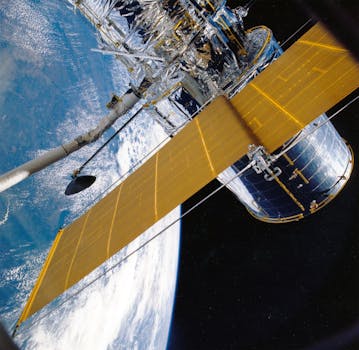Beyond Earth: How Recent Advances Are Shaping Satellite Telecommunications

Beyond Earth: How Recent Advances Are Shaping Satellite Telecommunications
Recent advances in satellite telecommunications are transforming the way we communicate and access information. With the increasing demand for global connectivity, satellite technology is playing a crucial role in shaping the future of telecommunications. Beyond Earth, satellite telecommunications are extending the reach of communication networks, providing connectivity to remote and underserved areas, and enabling new applications and services.
Introduction to Satellite Telecommunications
Satellite telecommunications involve the use of satellites in orbit around the Earth to transmit and receive signals. These signals can be used for a variety of purposes, including voice and data communications, television broadcasting, and internet connectivity. Satellites are particularly useful for providing connectivity to areas where terrestrial infrastructure is limited or non-existent, such as in remote or rural areas.
The use of satellites for telecommunications has been around for several decades, but recent advances in technology have significantly improved the capabilities and efficiency of satellite systems. New satellite constellations, such as those being developed by companies like SpaceX and OneWeb, are designed to provide global coverage and high-speed connectivity. These constellations consist of hundreds or even thousands of small satellites in low Earth orbit, which work together to provide a network of interconnected satellites.
Advances in Satellite Technology
Several recent advances in satellite technology are driving the growth and development of satellite telecommunications. One of the key advances is the development of new satellite constellations, as mentioned earlier. These constellations are designed to provide global coverage and high-speed connectivity, and are being used for a variety of applications, including broadband internet, mobile communications, and IoT connectivity.
Another significant advance is the development of new propulsion systems, which are enabling satellites to be launched into orbit more efficiently and at lower cost. Electric propulsion systems, for example, use electrical energy to accelerate ions or xenon gas, providing a high-specific-impulse propulsion system that is more efficient than traditional chemical propulsion systems.
Additionally, advances in materials science and manufacturing are enabling the development of lighter, more efficient, and more cost-effective satellites. The use of new materials, such as carbon fiber and advanced composites, is reducing the mass of satellites while maintaining their strength and durability. This is enabling the development of smaller, more agile satellites that can be launched into orbit at lower cost.
Applications of Satellite Telecommunications
Satellite telecommunications have a wide range of applications, from providing broadband internet access to remote and underserved areas, to enabling global connectivity for IoT devices. Satellite communications are also being used for mobile networks, providing connectivity to areas where terrestrial infrastructure is limited or non-existent.
Satellite telecommunications are also being used for a variety of other applications, including television broadcasting, navigation, and weather forecasting. The use of satellites for telecommunications is also enabling new services, such as satellite-based IoT connectivity, which is being used for applications such as smart cities, smart agriculture, and industrial automation.
The use of satellites for telecommunications is also providing new opportunities for scientific research and exploration. Satellites are being used to study the Earth’s climate, oceans, and land surfaces, and to explore the universe. The use of satellites for telecommunications is also enabling the development of new space-based technologies, such as satellite-based solar power and space-based manufacturing.
Challenges and Future Directions
Despite the many advances and applications of satellite telecommunications, there are still several challenges that need to be addressed. One of the key challenges is the issue of space debris, which is a growing concern as the number of satellites in orbit increases. Space debris can pose a significant risk to operational satellites, and can also contribute to the growing problem of orbital congestion.
Another challenge is the need for more efficient and cost-effective launch systems. The cost of launching satellites into orbit is still relatively high, and the development of more efficient and cost-effective launch systems is essential for the growth and development of satellite telecommunications.
Finally, there is a need for more regulatory frameworks and international cooperation to govern the use of satellites for telecommunications. The use of satellites for telecommunications is a global phenomenon, and requires international cooperation and regulatory frameworks to ensure that satellites are used in a responsible and sustainable manner.




